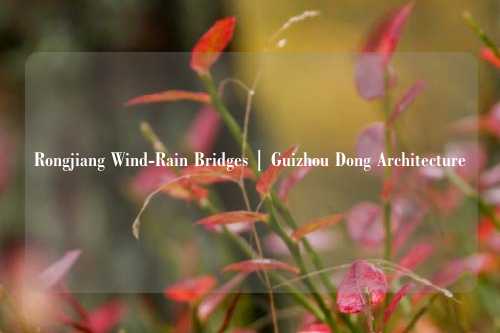Rongjiang Wind-Rain Bridges | Guizhou Dong Architecture
The Timeless Charm of Rongjiang Wind-Rain Bridges
Nestled in the heart of Guizhou Province, the Rongjiang Wind-Rain Bridges stand as stunning sentinels of a bygone era. These bridges are more than mere crossings; they are living remnants of the Dong culture, blending functionality with significance.

For初次 visitors to Rongjiang, the encounter with these bridges is nothing short of awe-inspiring. As one steps onto the bridge, the world seems to pause. The rustling of water below, the whisper of wind through bamboo railings, and the distant call of birds create a symphony of nature. Yet, amidst this tranquility lies a bustling community center. Here, the Dong people congregate, exchanging stories, discussing village matters, and celebrating festivals. The bridge is not just a pathway but a vibrant hub of daily life.
Dong architecture is renowned for its harmony with nature, and the Wind-Rain Bridges exemplify this. Crafted from readily available materials like wood, bamboo, and stone, these structures are a testament to the Dong's ingenuity. Each bridge is a marvel of engineering, designed to withstand the region's fierce winds and torrential rains, hence the name. The elevated design keeps the structure dry, while its durable materials ensure longevity.
Construction techniques, passed down through generations, highlight the Dong people's respect for their environment. Trees are selectively felled to ensure sustainability, and each component is carefully fitted without nails, showcasing their carpentry prowess. These bridges often feature carvings and communal halls, where events like weddings and festivals are celebrated, reflecting their dual role in practicality and culture.
As day turns to night, the bridge transforms once more. Lanterns illuminate the structure, casting long shadows that dance in the moonlight. The air fills with the scent of burning incense and the murmur of prayers, as the bridge becomes a place of worship for the local deity, Lushui Xian, revered for her protection of travelers. This sacred ambiance underscores the bridge's significance.
guardians of the past and symbols of resilience
Despite their enduring presence, the Rongjiang Wind-Rain Bridges face challenges. Time and weather take their toll, threatening these fragile structures. Heavy rains and landslides can damage framework and foundations, demanding constant vigilance and preservation efforts.
Tourism brings its own set of issues. While visitors appreciate the bridges' beauty, overcrowding can lead to wear and tear. The Dong people grapple with balancing tourism's economic benefits against the need to protect their heritage. Overheads signs and pathways have been introduced, but these modern additions sometimes clash with the bridges' aesthetics, sparking debates on preservation versus accessibility.
Efforts to protect these landmarks are underway. Local and national initiatives aim to restore bridges while integrating tourism practices, ensuring they remain functional without losing their ity. For instance, the Zhuhai Bridge near Rongjiang underwent restoration, using original materials and techniques, guided by elderly villagers who had learned the craft from their ancestors.
For the Dong, these bridges are more than buildings; they are symbols of resilience and heritage. Even as modernity encroaches, the bridges stand steadfast, embodying the community's strength and their enduring connection to nature and tradition.
In a world where progress often erases the past, the Rongjiang Wind-Rain Bridges remind us of the value of preserving heritage. They invite us to reflect on the harmony between man and nature, and the importance of safeguarding our collective history. As we traverse these bridges, we carry not just the weight of tradition, but the hope that future generations may continue to experience their timeless beauty.
















